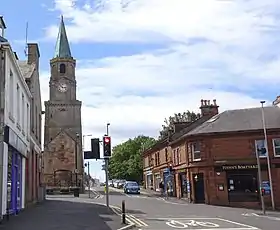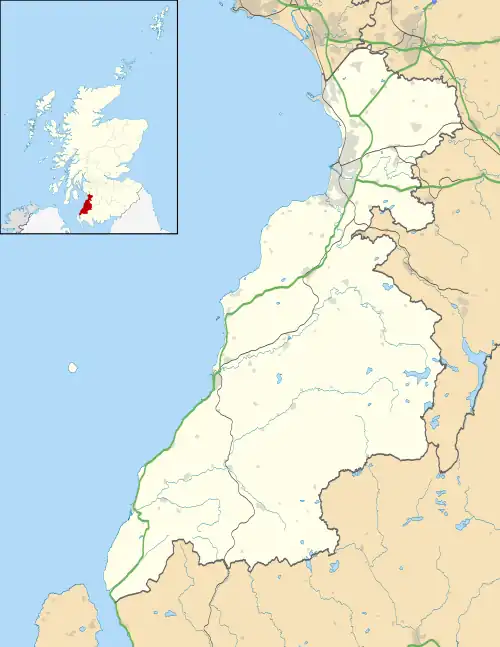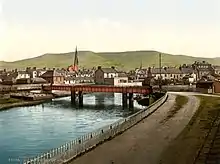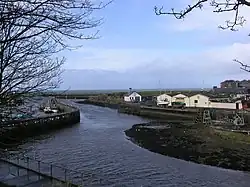Girvan
| |
|---|---|
| Burgh | |
 Girvan Steeple, South Ayrshire. | |
 Girvan Location within South Ayrshire | |
| Population | 6,330 (mid-2020 est.)[1] |
| Demonym | Girvanite |
| OS grid reference | NX185975 |
| • Edinburgh | 81 mi (130 km) |
| • London | 323 mi (520 km) |
| Council area | |
| Lieutenancy area | |
| Country | Scotland |
| Sovereign state | United Kingdom |
| Post town | GIRVAN |
| Postcode district | KA26 |
| Dialling code | 01465 |
| Police | Scotland |
| Fire | Scottish |
| Ambulance | Scottish |
| UK Parliament | |
| Scottish Parliament | |
Girvan (Scottish Gaelic: Inbhir Gharbhain, "mouth of the River Girvan")[2] is a burgh and harbour town[3] in Carrick, South Ayrshire, Scotland. Girvan is situated on the east coast of the Firth of Clyde, with a population of about 6,450. It lies 21 miles (34 km) south of Ayr, and 29 miles (47 km) north of Stranraer, the main ferry port from Scotland to Northern Ireland.
Deriving its name from the river which runs through the landscape the etymology of Girvan has possible Brythonic origins, related to the Welsh: Gearafon or Gwyrddafon, "river flowing through the green flourishing place, from afon or avon, a river, and Gwyrdd, green, flourishing").[4]
Prehistory and archaeology
The earliest evidence of human habitation in the Girvan area dates to the Mesolithic.[5]
Between 1996 and 1998, archaeological investigations were undertaken by GUARD archaeology (then part of the University of Glasgow) as part of an expansion of the William Grant & Sons distillery. This work discovered several burnt mounds that dated to the later third millennium/early second millennium BC and an Iron Age trackway. They also discovered a Medieval moated enclosure, which is a house or compound surrounded by a moat. These are usually the homes of minor aristocracy but are rare in Scotland (of the roughly 5400 known from mainland Britain, only ~120 are in Scotland). It is surmised that it might have belong to the Bruce family group, either a relative or a supporter and that it was likely that the house would have been known to Robert the Bruce, as he was born at Turnberry.
Two Roman camps lie half a mile (0.8 km) north of the estuary of the Water of Girvan in level fields of Girvan Mains Farm. The discovery of a fragment of a late first-century glass vessel in the primary ditch-fill of the second camp, combined with the almost square plan of the first, makes it entirely reasonable to assume that these were bases used by the forces of Agricola during the campaigns 78-84 AD mentioned by Tacitus in (de Vita Agricolae, cap xxiv) as relating to a possible descent upon Ireland. The provision of a beach head at either site would have allowed the camps to fulfill the function of a base for Agricolan combined army and naval operations around the Scottish coast.[6]
History
Girvan was originally a fishing port. In 1668, it became a municipal burgh incorporated by charter.[7]
The opening of the railways, initially with the Maybole and Girvan Railway at the end of the 1850s, encouraged the development of Girvan as a seaside resort[7] with beaches and cliffs. Holidaying here from 1855 to 1941 were Robert and Elizabeth Gray and their children; particularly Alice and Edith Gray. The family, led principally by Elizabeth and Alice, created scientifically organised collections of fossils for several museums including the Natural History Museum.[8]
Just north of the town is Grangestone Industrial Estate, which hosts a William Grant & Sons distillery which opened in 1964. There is a Nestlé factory that manufactures chocolate that is shipped down to York and used in Kit Kat and Yorkie bars.[7]
Transport
Girvan railway station is served by ScotRail on the Glasgow Central to Stranraer line. All services call here, and several more start/terminate here.
Girvan is also served well by bus. Stagecoach West Scotland provide some of Girvan's bus services;
58/60: Ayr to Girvan
358/360: Ayr/Girvan to Stranraer
359: Girvan to Newton Stewart/Isle of Whithorn
Other bus services;
By Shuttle Buses;
362: Girvan to Colmonell
363: Colmonell to Kilwinning
By South Ayrshire Community Transport;
CB8: Girvan to Barr
Places of interest
Knockcushan Gardens contains the old 'Hill of Justice' stone and a plaque records that King Robert the Bruce, Earl of Carrick held a court here in 1328.
The McKechnie Institute was endowed by local businessmen Robert and Thomas McKechnie, was opened in 1889.[9]
Culzean Castle is about 8 miles (13 km) north of the town, and the volcanic island of Ailsa Craig is visible about 10 miles (16 km) offshore. Turnberry golf course and hotel are located 5 miles (8 km) north of Girvan. The coastline south of Girvan is famous for its geology, and also for the Sawney Bean Caves at Bennane Head or Balcreuchan Port, where the murderer and cannibal Sawney Bean supposedly lived until his arrest and execution in Edinburgh.
Local festivals


Girvan RNLI harbour gala takes place each summer, usually in July, with music, stalls, fun fair, rescue displays and emergency services. Girvan Lifeboat station recently received their new Shannon Class all-weather lifeboat, powered by water jets making it the most manoeuvrable and capable all-weather boat in the fleet. 13-23 Elizabeth and Gertrude Allan is the 2nd Shannon Class lifeboat in Scotland and the 1st on the west coast.
The Girvan Traditional Folk Festival takes place on the first weekend of May each year.[10] Girvan also has a folk music club.
The Lowland Gathering takes place on the first Sunday of June each year in the Victory Park in the centre of the town.
The annual Festival of Light takes place in October with a six-week lantern project resulting in the river of light lantern procession and shorefront performance. The autumn lantern project is a celebration of the lanternmakers and the people of Carrick.[11]
Education and community

Girvan has its own secondary school, Girvan Academy, which the majority of local children attend. Roman Catholic families have the option of Queen Margaret Academy in Ayr. There are also two primary schools, Girvan Primary School (non-denominational) and Sacred Heart Primary School (denominational) and there is one non-denominational specialist school, Invergarven School.[12]
The town's swimming pool was closed in 2009 by South Ayrshire Council, on the grounds that it had reached the end of its operational life. The building has since been demolished. A new leisure centre, named 'The Quay Zone' was officially opened on 26 April 2017. 'The Quay Zone' was built in a way to help redevelop Girvan. It is sited on the old swimming pool's location at the harbour.[13][14]
Churches
Girvan has a Roman Catholic church, "Sacred Hearts of Jesus and Mary", built around 1863. The Church is in Harbour Lane, situated between Louisa Drive and Henrietta Street, close to the junction with Ailsa Street West. For many years the convent and the church were closely connected with Roman Catholic primary and secondary schools in Girvan, whilst the secondary school closed a number of years ago [and the building converted to flats], the primary school has recently been demolished and rebuilt and continues to this day as a thriving primary school.
The entity known as "The Charles" also has its own place of worship within the town.
Girvan has two Church of Scotland congregations: Girvan North Parish Church in Montgomerie Street (with a spire over 100 feet or 30 metres tall) and Girvan South Parish Church.
Milestone Christian Fellowship, a local congregation which began meeting in Girvan's Community Centre in 2005, moved into a redeveloped nightclub on Bridge Street in 2016.[15] Milestone is a member of the Baptist Union of Scotland.
The town's Episcopalian congregation of St John was closed in 2014: they had been using the town's Methodist church building for services after their building became unusable in 2009.[16]
Twin town
![]() Torcy, Seine-et-Marne, France - in honour of a Scottish knight named Sir Thomas Huston originally from Girvan, who fought the English as part of the Auld Alliance during the Hundred Years War. Rewarding him for his bravery during the capture of Meaux in 1439, the King of France granted him the fiefdom of Torcy.
Torcy, Seine-et-Marne, France - in honour of a Scottish knight named Sir Thomas Huston originally from Girvan, who fought the English as part of the Auld Alliance during the Hundred Years War. Rewarding him for his bravery during the capture of Meaux in 1439, the King of France granted him the fiefdom of Torcy.
Notable people
- Andrew Gallacher, racing driver
- Peter McCloy, footballer
- Rory Wilson, footballer
- Greig Young, footballer
Climate
Girvan has an oceanic climate (Köppen: Cfb).
| Climate data for Girvan (9 m or 30 ft asl, averages 1991–2020) | |||||||||||||
|---|---|---|---|---|---|---|---|---|---|---|---|---|---|
| Month | Jan | Feb | Mar | Apr | May | Jun | Jul | Aug | Sep | Oct | Nov | Dec | Year |
| Mean daily maximum °C (°F) | 7.9 (46.2) |
8.2 (46.8) |
9.7 (49.5) |
12.4 (54.3) |
15.4 (59.7) |
17.6 (63.7) |
19.0 (66.2) |
18.8 (65.8) |
16.9 (62.4) |
13.6 (56.5) |
10.4 (50.7) |
8.5 (47.3) |
13.2 (55.8) |
| Mean daily minimum °C (°F) | 3.2 (37.8) |
3.1 (37.6) |
3.9 (39.0) |
5.4 (41.7) |
7.7 (45.9) |
10.6 (51.1) |
12.3 (54.1) |
12.2 (54.0) |
10.5 (50.9) |
7.9 (46.2) |
5.4 (41.7) |
3.4 (38.1) |
7.1 (44.8) |
| Average rainfall mm (inches) | 109.6 (4.31) |
87.2 (3.43) |
84.7 (3.33) |
61.0 (2.40) |
58.9 (2.32) |
56.8 (2.24) |
78.9 (3.11) |
85.4 (3.36) |
81.0 (3.19) |
123.0 (4.84) |
123.0 (4.84) |
122.7 (4.83) |
1,072.2 (42.2) |
| Average rainy days (≥ 1 mm) | 17.4 | 14.6 | 14.0 | 11.5 | 11.2 | 11.3 | 12.8 | 14.4 | 13.6 | 16.4 | 17.3 | 17.2 | 171.7 |
| Mean monthly sunshine hours | 40.2 | 63.9 | 101.8 | 154.1 | 200.9 | 166.6 | 159.5 | 152.1 | 114.4 | 79.8 | 49.6 | 36.2 | 1,319.1 |
| Source: Met Office[17] | |||||||||||||
See also
- Lendalfoot - a nearby village.
- Girvan Community Hospital
References
- ↑ "Mid-2020 Population Estimates for Settlements and Localities in Scotland". National Records of Scotland. 31 March 2022. Retrieved 31 March 2022.
- ↑ "Ainmean-Àite na h-Alba - Gaelic Place-Names of Scotland - Database". 6 March 2016. Archived from the original on 6 March 2016. Retrieved 2 December 2022.
- ↑ "Girvan-Online.net". Archived from the original on 29 October 2013. Retrieved 26 October 2013.
- ↑ Arthur, William (1857). An Etymological Dictionary of Family and Christian Names: With an Essay on Their Derivation and Import. Sheldon, Blakeman & Company.
- ↑ MACGREGOR, GAVIN; DONNELLY, MICHAEL; MILLER, J.; RAMSAY, S.; ALLDRITT, D.; Donnely, Mike (2001). "A Mesolithic Scatter from Littlehill Bridge, Girvan, Ayrshire". Scottish Archaeological Journal. 23 (1): 1–14. doi:10.3366/saj.2001.23.1.1. ISSN 1471-5767. JSTOR 27917444.
- ↑ Arthur, William (1857). An Etymological Dictionary of Family and Christian Names: With an Essay on Their Derivation and Import. Sheldon, Blakeman & Company.
- 1 2 3 "Girvan; South Ayrshire". Gazetteer for Scotland. Retrieved 16 December 2014.
- ↑ Bulletin of the British Museum (Natural History) Vol. 17 (reprint ed.). London: British Museum. 2013. pp. 170–252. ISBN 978-0-565-09011-1. Retrieved 22 November 2015.
- ↑ "McKechnie *fInstitute". South Ayrshire Council. Retrieved 16 December 2014.
- ↑ "Girvan Traditional Folk Festival". Retrieved 8 April 2022.
- ↑ "Local legends fire up for Girvan's Festival of light". S1Girvan.com. 5 November 2010. Archived from the original on 23 March 2012. Retrieved 1 May 2011.
- ↑ "Our School". Invergarven School. Retrieved 2 June 2018.
- ↑ "Girvan pool: Your questions are answered".
- ↑ "The Quay Zone Girvan. The website gives detailed information about the building and what you can do!". thequayzone.co.uk. Retrieved 28 April 2017.
- ↑ "Praise for new church as it takes over old Girvan nightspot" Daily Record. 28 February 2016. Retrieved 28 March 2016.
- ↑ "St John's final service in Girvan tomorrow". Carrick Gazette. 17 May 2014. Retrieved 18 May 2014.
- ↑ "Girvan (South Ayrshire) UK climate averages". Met Office. Archived from the original on 8 November 2023. Retrieved 8 November 2023.
External links
- About Girvan Archived 25 May 2009 at the Wayback Machine

